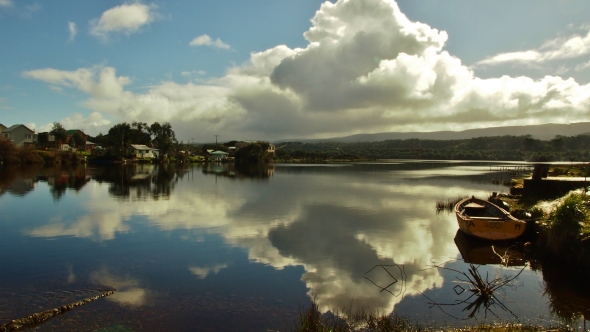With the weather hitting a rainy patch we bee lined south to the Island of
Chiloe. With its green forest, lush rolling hills and wild pacific coast we felt it was a stunning place to visit what ever the weather. We stayed the night in Puerto Octay on the southern mainland. A German influenced lakeside town that was shutdown in the winter. We camped by the lake on a quiet road. Not quiet enough as the police banged on the window to see what we were up to. A quick check of our passports at 3am and a sleepy response before they bade us a good holiday in Chile. Next morning we caught the ferry across to the island and the port of Chacao.

We then headed west to where there is the Penguin sanctuary past Ancud. A desolate place in winter, the fast flowing ford to the beach was too high to cross so we parked up and wandered over a foot bridge. The rain was lashing down as we sheltered in the CONAF park hut. We watched a good documentary about the penguins in English that the helpful warden had found us, before a break in the weather let us strain our eyes to spot penguins. We saw a few outlines on the nearest island that the warden informed us were penguins, maybe! It was just great to be in such a wind lashed place in the dark heart of a southern winter, just a few hardy souls spotted working on boats or hanging about, certainly no tourists littering the beach.
After the penguin sanctuary we drove down a back road to Chepu. The rain was still lashing down as the road narrowed and steepened, then when we were halfway down a steep descent, the road fell away, we stopped on a flatter section to inspect. It had washed out. We tried reversing back up but there was no traction. We were stuck in the middle of nowhere on Chiloe which is already the middle of nowhere!! After some road works to widen the road with rocks and a 25 point turn we managed to get back to point uphill again. Then on the 3rd uphill attempt we managed to keep traction and reclimb the hill. At this point is was getting gloomy and the rain was still falling. We cautiously made it back to the bigger road and took the long way around! The road to Chepu in the wet wasn’t great but it was all driveable. We camped up on a random spot for a night listening to a chorus of frogs while hoping we wouldn’t be flooded in place tomorrow!
Chepu was isolated, we didn’t really know what to do, so we kept driving. We eventually arrived above the large beach at the head of an impossible rough and steep track down. We didn’t want to get stuck again so parked up and walked down. Some men on horses overtook us slowly treading down the track. The beach and dunes were vast, the featured image above shows some fairly wild horses roaming the wild expanse. We climbed headlands and over dunes past, arches and sea stacks, huge waterfalls spilling onto the beach. Then at the end some of the beach we saw women cutting and preparing seaweed. We saw a couple of local men on horses striding along the beach dragging huge bales of sea weed that they had prepared.
After detouring to Castro’s markets and the stilted houses, we headed due west to the national park of Chiloe past the two lakes and on to Cucao. A village at the end of the world, where it was fair to say the sunsets are amazing.
The next day was spent wandering the beach as far as the national park. The setting was remote with just the odd shack settled up the cliffs above the beach. These must belong to the few fishermen working the coast. We passed an old brightly coloured stock bridge crossing the river at the back of the beach for the cattle that are still in places grazing the dunes and back of the beach. This also linked the odd houses in the cliffs. The area at first felt empty but sitting down taking time we spotted an old lady with a large bag collecting driftwood, an old jeep pulled up before the river ford crossing. Two men got out put on neoprene trousers and waded into the sea. Another truck crossed the ford with water up to the bonnet. It survived. The tide then receded enough that a herd of trucks appeared with the men all wading into the sea to harvest shellfish. The seagulls were also harvesting them, they dropped them onto the hard sand to crack them open.
The tranquility of the place in our rare winter sunshine was infectious we stayed in a deserted campground, where they kindly let us use showers in a summer rental cabin. We stayed longer than expected hiking and admiring the sunsets. The island is famous for its wooden churches of varying designs across all the 3o islands that make the area up. These were all quaint with some bright coulors and unique designs, the most interesting ones are covered by a UNESCO World Heritage designation.

The island has a slow way of life, preserving some ancient traditions that have long been lost on the mainland. A unique Chilote population still populates most of the island. Oxen pulled carts in the fields, where cattle grazed bright green grass. It really felt like time had stood still here. It has nothing of spectacular note but that is not the beauty of Chiloe, it is soaking in a way of life that exists in few other places on earth.


[…] The magical island of Chiloe, Chile (welovemountains.wordpress.com) […]